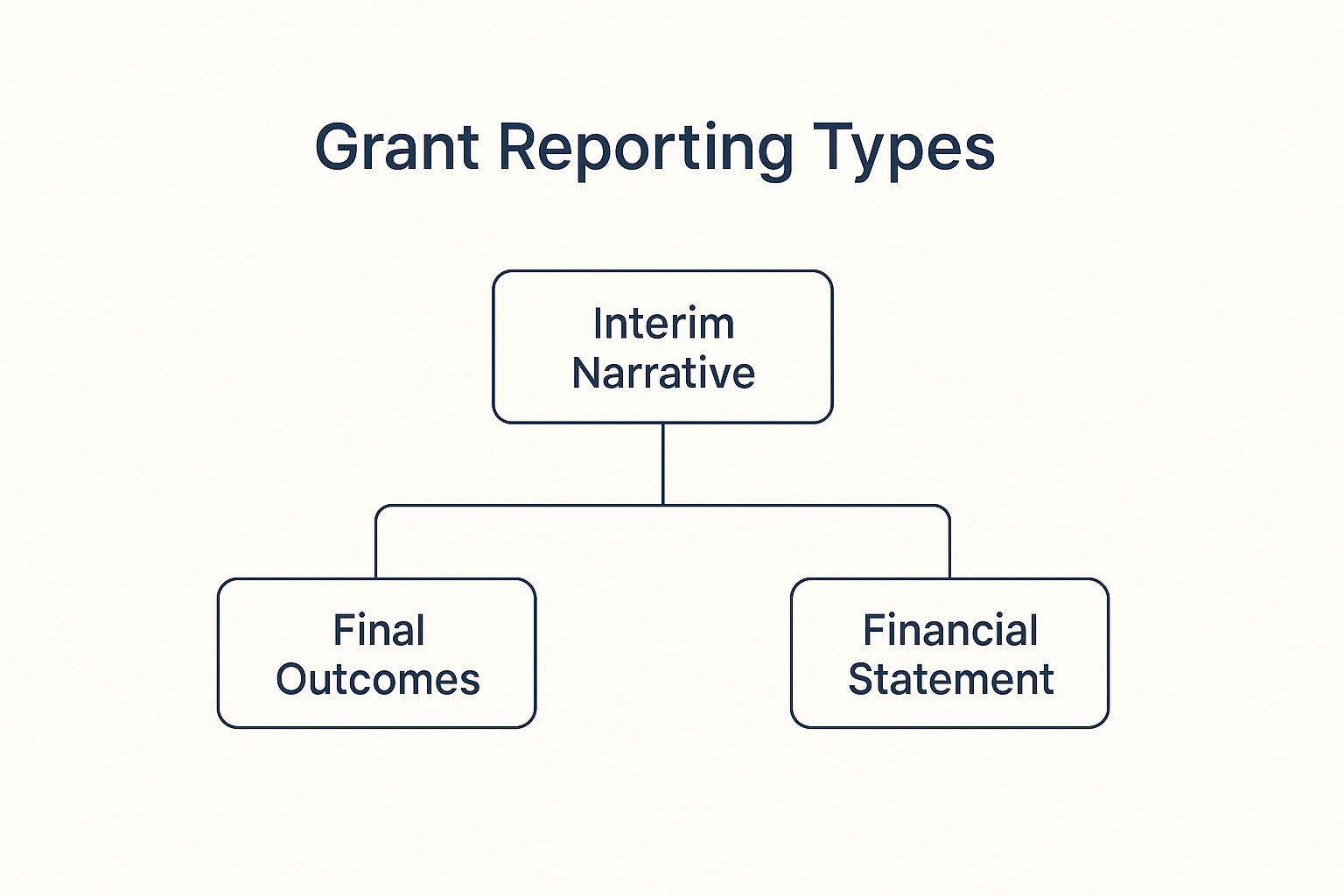
Grant reporting requirements are the specific instructions and formats a funder gives you for reporting on your project's progress, spending, and results. It's easy to see this as just another administrative chore, but that's a mistake. The best way to think about it is as the structured conversation that builds trust and accountability, proving your funder’s investment is making a real-world difference. This ongoing dialogue is essential for staying in good standing and opening the door to future support.

What’s Really Behind the Paperwork?
Let's be honest, the term "grant reporting" can make even the most seasoned nonprofit professional groan. It often brings to mind late nights spent wrestling with spreadsheets and digging through receipts. But what if we reframed it? Instead of a hurdle, think of reporting as the ultimate tool for sharing your story—a story of impact, progress, and responsible financial management.
These requirements aren't just about ticking boxes for compliance. They form the very foundation of a strong, transparent partnership between you and your funder. When you meet them, you're doing more than just sending a document; you're actively showing that you're a reliable and effective steward of their investment.
At the end of the day, every report you submit is designed to answer the funder’s big-picture questions about the project they've put their faith in. These questions almost always fall into three main buckets, which form the core components of your report.
To give you a clearer picture, this table breaks down the three essential report types and what funders are truly looking for in each one.
The Core Components of Grant Reporting
Each of these components works together to provide a complete and honest account of your work. The specifics will always trace back to your initial agreement, which is why it's so important to understand the key donor agreement considerations before you even begin.
Grant reporting is more than just a requirement; it's a strategic tool. It’s your opportunity to prove your organization's value, build trust with funders, and create a compelling case for continued partnership.
An Ever-Changing Field
The world of grant management isn't static. As the funding environment grows more competitive and complex, so do the expectations for reporting. Federal and state funders, in particular, are facing a growing need for modern grant management tools to keep up with new policies and a demand for greater transparency.
This push is changing how everyone operates. Shifting federal guidelines are driving a major evolution in grantmaking practices, compelling organizations of all sizes to adopt better digital systems.
Ultimately, getting a handle on these requirements is non-negotiable for success. For a real-world look at how one organization tackled these very challenges, check out our case study on https://unify.scholarfundwa.org/case-study/nonprofit-reporting-requirements. When you start seeing reporting as a strategic asset, you can turn it from a burden into one of your most powerful tools for growth.
The Three Pillars of Grant Reporting
Every solid grant report is built on three key pillars: the money, the metrics, and the story. When you understand how these parts work together, you can create a report that not only meets all the official grant reporting requirements but also paints a vivid picture of your impact.
Let’s unpack these pillars one by one. Getting this right means you’ll submit a report that's both fully compliant and genuinely compelling.
This image shows how different reports—from quick interim updates to detailed final financials—all come together to tell the full story of your grant's journey.

As you can see, grant reporting isn’t a one-and-done task. It’s an ongoing process that blends narrative storytelling with hard financial data at every stage.
Pillar 1: The Financial Report
First up is the financial report. This is the most black-and-white part of the process, all about fiscal accountability. Its main job is to prove you've managed the funder's money responsibly and exactly as you laid out in your budget. It’s the hard evidence of your good stewardship.
Let’s say you received a $50,000 grant for a new community arts program. Your financial report would give a detailed accounting of how every dollar was used. This isn't just a high-level summary; it’s a line-by-line comparison of your proposed budget against what you actually spent.
A rock-solid financial report typically includes:
- Budget vs. Actuals: A clean table showing each budget line item (like art supplies, instructor fees, or venue rental) with the planned amount next to the amount spent.
- Supporting Documentation: This is your proof. Think scanned receipts, invoices, and payroll stubs for any expense tied to the grant.
- Explanations for Variances: A few quick notes explaining any big differences from the budget. Did you find a cheaper venue? Did art supplies cost more than you thought? Explain why.
This pillar is all about transparency. A flawless financial report builds incredible trust and assures your funder their investment is in capable hands.
Pillar 2: The Performance Report
Next, we have the performance report, which you might also know as a progress report. If the financial report covers the money, the performance report covers the action. This is where you lay out the hard data showing your project is on track and hitting its goals.
Your metrics and milestones are the stars of this section. If your arts program promised to serve 100 underserved youth, your performance report would show exactly how many participants you enrolled each month. It directly answers the funder's question: "Are you actually doing what you said you would do?"
Your performance report is the bridge between your day-to-day activities and the big-picture outcomes you promised. It turns your work into numbers your funder can see and understand.
To build a strong performance report, you’ll want to:
- Track Key Metrics: Consistently gather data on your key performance indicators (KPIs). For a community health program, this might be the number of patients screened or workshops held.
- Report on Milestones: Clearly state which project goals you hit during the reporting period. For instance, "Completed facilitator training in Month 1" or "Launched community outreach campaign in Month 2."
- Present Data Clearly: Don't just dump numbers into a paragraph. Use simple charts, graphs, and tables to make your progress easy to grasp in seconds.
Think of this report as showing the project's vital signs. It gives the funder a clear, objective snapshot of your project's health and momentum.
Pillar 3: The Narrative Report
The final pillar is the narrative report. This is your chance to breathe life into the cold, hard data from the other two pillars. It’s where you tell the story behind the statistics—sharing the human impact, the real-world context, and the important lessons you learned along the way.
So, your financial report shows you spent $5,000 on supplies, and your performance report shows 75 youth attended. The narrative is where you explain what that experience was really like. You might share a powerful quote from a student who gained new confidence or describe an unexpected partnership that grew out of the program.
A compelling narrative report always includes these three things:
- Success Stories: Go beyond the numbers to highlight specific wins. Share anecdotes that truly illustrate the impact your work is having on people’s lives.
- Honest Challenges: No project is perfect. Being open about the obstacles you faced—and how you adapted to solve them—shows resilience and builds far more credibility than pretending everything went smoothly.
- Lessons Learned: What did you discover? What would you do differently next time? This shows you’re a learning organization committed to getting better.
For many organizations, especially those in tribal or underserved communities, complicated reporting can be a huge hurdle. A GAO report pointed out that overly complex requirements can stop critical funding from getting to where it's needed most. A clear, honest narrative helps bridge that communication gap.
This final pillar is what turns your report from a simple requirement into a powerful story of change, strengthening your relationship with the funder for years to come.
Navigating International Grant Reporting Rules

When your work crosses borders, so does your paperwork. Taking on an international grant adds entirely new layers to the reporting process, turning what might be a familiar task into a complex puzzle. As philanthropy and aid have gone global, the demand for airtight transparency and compliance has grown right along with it.
Think of it this way: if domestic grant reporting is like following a local city map, international reporting is like navigating a world atlas. You're dealing with different languages, different rules of the road, and completely different legal jurisdictions for every country you operate in. The goal is the same—to show you're on track—but the skills and tools required are far more demanding.
This global reality means organizations have to step up their compliance game. For international funding, your grant reporting requirements aren't just about showing your impact. They're about proving every single dollar was used ethically, legally, and in line with multiple, sometimes conflicting, sets of regulations.
The Rise of Stricter Global Standards
One of the biggest shifts we've seen in international funding is a strong push toward tougher regulations and greater public disclosure. Funders, especially government agencies and major foundations, are under intense pressure to stop fraud, corruption, and the misuse of funds. That pressure gets passed directly to their grantees, who now have to provide ironclad proof of their activities.
For instance, a proposed piece of legislation in the United States, the Foreign Grant Reporting Act (H.R. 8290), would require 501(c) organizations to publicly disclose any grants made to foreign entities. The act would mandate reporting the name, address, and organizational type of foreign recipients, plus details on their subgrantees. You can review the proposed changes to grant reporting to see what this could mean for funders.
This trend highlights a crucial point: working across borders demands a much higher level of diligence than ever before.
Key Focus Areas for International Compliance
To stay on the right side of these rules, you need to focus on a few critical areas that get the most scrutiny in international grants. These are the checkpoints where funders look first to make sure their investment is safe and sound.
Key areas include:
- Enhanced Due Diligence: You have to thoroughly vet not just your main international partners but also any sub-grantees or key vendors they bring on. This is your best defense against accidentally associating with sanctioned individuals or organizations.
- Traceability of Funds: It’s not enough to say where the money went; you must be able to trace its entire journey. This means having meticulous financial records that map the flow of funds from your organization all the way to the final point of use.
- Understanding Local Laws: Every country has its own laws governing nonprofits, banking, and employment. It's on you to understand and comply with these local rules, which can be wildly different from what you're used to at home.
Navigating international grant reporting is about building a system of trust that spans continents. Your ability to provide clear, verifiable, and compliant reports is the bedrock of that trust and the key to sustaining your global impact.
How to Prepare for International Reporting
So, how do you get your organization ready to meet these heightened expectations without grinding your mission to a halt? It all starts with building a solid internal infrastructure long before the first report is due.
Here are three practical steps you can take right now:
- Upgrade Your Data Systems: Let's be honest, spreadsheets just don't cut it for tracking international funds. You need a centralized system that can handle multi-currency transactions, track expenses with precision, and generate detailed reports at a moment's notice.
- Develop In-Country Expertise: Don't try to go it alone. Partner with local experts who know the legal and financial landscape inside and out. This could be a local accounting firm, a legal advisor, or an experienced project manager who lives and works in the country.
- Standardize Your Vetting Process: Create a formal, documented process for vetting every international partner and sub-grantee. This checklist should be followed religiously every single time to ensure you're consistent and minimizing risk.
By preparing proactively, you can manage international grants with confidence, meet every requirement, and focus on the vital work you do around the world.
Common Grant Reporting Mistakes to Avoid
Even the most buttoned-up organizations can trip up on grant reporting. The maze of grant reporting requirements is complex, and one small misstep can cause major headaches, delay payments, and even put your relationship with a funder on thin ice.
The good news? Most of these mistakes are completely avoidable.
Think of your grant report as the final chapter in the story of your project. You've already done all the hard work—running the program, serving the community, and managing the budget. A reporting mistake is like a typo on the last page that distracts from an otherwise incredible story. This section will walk you through the most common pitfalls so you can build better habits and submit every report with total confidence.
Mismatched Financials and Vague Narratives
One of the most glaring errors we see is when the numbers and the narrative don't tell the same story. This happens when your financial statement, performance metrics, and narrative report feel like they came from three different organizations.
For instance, your narrative might celebrate a fantastic new community outreach event, but the financial report shows zero spending on marketing or event staff. That kind of disconnect immediately raises a red flag for a grant manager. It signals disorganized bookkeeping at best, and at worst, it could imply funds weren't used as intended. It chips away at the trust you've worked so hard to build.
Another common problem is a story without substance. Reports filled with generic phrases like "we made great progress" or "the program was a success" don't cut it. Funders need to see the proof. They want concrete data and real-life examples, not just feel-good assurances.
How to Get Your Story Straight
The fix for these issues comes down to two things: alignment and detail. Your entire reporting process needs to be built around making sure your financials, performance data, and narrative are perfectly in sync.
Here’s a practical way to do it:
- Hold Regular Internal Check-ins: Don't wait until the day before the deadline to sort everything out. Get your program and finance teams in the same room every month or quarter to review spending and progress together. This simple meeting ensures everyone is on the same page long before the report is due.
- Tag Everything as You Go: Use your accounting software to tag every single expense related to the grant the moment it happens. This one habit makes pulling an accurate budget vs. actuals report almost effortless. For a closer look at this in action, check out our case study on effective nonprofit financial management.
- Tell a SMART Story: Give your narrative teeth by framing it around SMART goals (Specific, Measurable, Achievable, Relevant, Time-bound). Instead of saying "we helped a lot of kids," try "we provided after-school tutoring to 75 children in Q3, surpassing our original goal of 60."
A grant report is a conversation with your funder. Vague or mismatched information creates confusion and static. Clear, aligned, and detailed reporting ensures your message is heard loud and clear.
Missing Deadlines and Ignoring Funder Communication
Blowing past a submission deadline is more than a simple slip-up. It can trigger a formal compliance review and bring future payments to a screeching halt. A GAO report has even noted how complex reporting requirements can be a major hurdle, especially for smaller nonprofits with limited staff.
Just as damaging is radio silence. If you know you're going to be late or a major challenge has popped up, ghosting your funder is the worst thing you can do. Remember, they are your partners. They would much rather hear about a problem directly from you than be surprised by it later.
Creating a Pre-Submission Safety Net
To dodge these common issues, it's wise to build a simple but effective safety net. A pre-submission checklist helps you catch potential errors before they ever reach your funder, transforming a stressful deadline into a routine quality check.
Here is a checklist you can adapt to build a more resilient reporting process and prevent common mistakes before they happen.
Reporting Pitfall Prevention Checklist
This practical checklist outlines common grant reporting errors and the preventative actions you can take to ensure accurate and timely submissions.
By making this checklist a standard part of your workflow, you can systematically eliminate the most common errors. This not only streamlines your internal processes but also reinforces the trust that is absolutely essential for securing long-term funding.
Using Technology for Smarter Reporting

If you’ve ever found yourself wrestling with scattered spreadsheets or digging through old email threads for a single receipt, you know the pain of manual grant reporting. This old-school approach to meeting grant reporting requirements isn't just a time-sink; it's riddled with risk. It’s time to let technology do the heavy lifting.
Modern grant management software can turn this administrative headache into a smooth, organized workflow. Instead of constantly reacting to looming deadlines, you can get ahead of the curve, managing your grant’s entire lifecycle from one central hub. This isn't just a nice-to-have anymore—it's becoming essential.
The demand for these tools tells the whole story. The global grant management software market, valued at USD 3.07 billion, is expected to more than double to USD 7.44 billion by 2034. This surge is driven by a clear need for automated solutions that bring much-needed efficiency and transparency to the grant world. You can discover more about the grant management software market to see just how fast things are changing.
This growth points to a major shift: organizations are ditching their patched-together systems for integrated platforms that make compliance easier and help demonstrate their true impact.
Centralize Your Grant Universe
The most immediate benefit of grant management technology is centralization. Think of it as a single digital command center for everything related to your grants. No more hunting for that one crucial document or trying to figure out which budget spreadsheet is the most current.
A dedicated platform pulls it all together:
- Document Storage: The grant agreement, original proposal, budgets, and all supporting paperwork live in one secure, easy-to-find place.
- Financial Tracking: Every single expense gets logged and categorized against the grant budget in real-time. This turns financial reporting into a simple click of a button instead of a week-long scramble.
- Deadline Management: With automated reminders and a clear calendar of all reporting due dates, you can finally stop worrying about missing a critical submission.
This centralized approach creates what experts call a "single source of truth." It wipes out the confusion and errors that are almost inevitable when you’re juggling information across different, disconnected systems.
Automate Compliance and Tell a Better Story
Good technology goes way beyond just keeping you organized. It fundamentally changes how you prove compliance and, just as importantly, how you tell your story. Advanced platforms don't just store your data; they help you understand it.
To get the most out of this, it's a good idea to evaluate specific accounting platforms like Xero and see how they can plug into your larger grant management system.
Once your systems are talking to each other, you unlock the real magic.
A compliance dashboard can instantly flag any spending that falls outside the approved budget, giving you a chance to correct course long before it becomes a problem on a report. This kind of proactive oversight is a game-changer for maintaining trust with your funders.
Even better, these tools are built to connect your spending directly to your outcomes. They help automate the process of linking financial data with your performance metrics. This means you can generate reports that don't just show what you spent, but prove why that spending made a difference. Technology doesn't just simplify reporting—it helps you build a more powerful, data-driven case for your impact and strengthen your relationships with funders.
Building a Culture of Proactive Grant Compliance
Let’s be honest: great grant reporting isn’t just about ticking a box at the end of a funding cycle. It's a living, breathing testament to your organization's integrity and commitment. When you shift from a reactive, last-minute scramble to a proactive culture of compliance, something powerful happens. Submissions get easier, and you cement your reputation as a trustworthy partner who deserves continued investment.
Think of it less like a final exam and more like an ongoing conversation. This new approach begins the second you get that award notification—long before the first reporting deadline is even on your radar.
Start a Calendar on Day One
Here’s the single most impactful thing you can do for proactive compliance: build a comprehensive reporting calendar the day you receive the grant. Don't put it off. Once that agreement is signed, immediately map out every single deadline—interim, final, financial, and narrative—for the entire life of the grant.
This calendar is your North Star. It keeps grant reporting requirements front and center, preventing the panicked, eleventh-hour rush that almost always leads to mistakes. A shared calendar also creates a sense of collective ownership across your team, turning compliance into a group effort.
The ultimate goal is to treat reporting as an ongoing conversation with your funder. This proactive approach not only simplifies the submission process but also builds a foundation of trust that is essential for long-term partnerships.
Just as critical is clarifying who’s responsible for what. Your calendar should name a specific owner for each task, from pulling financial reports to drafting the final story. This simple step cuts through confusion and guarantees every piece of the puzzle is handled by the right person at the right time. For a deeper dive into how clear roles contribute to organizational health, check out our guide on nonprofit compliance for nonprofit organizations.
Communicate Early and Often
Your relationship with your funder is one of your most valuable assets. Proactive communication is how you build and protect it. The formal report should never be the only time your program officer hears from you.
Drop them a quick, informal email to share an exciting win or a key milestone. If you hit an unexpected roadblock, let them know immediately and explain your plan to navigate it. That kind of transparency demonstrates that you see them as a genuine partner in your mission, not just a piggy bank.
Of course, this open communication needs to be backed by solid internal systems. Following smart document management habits is non-negotiable for keeping your records accurate, auditable, and aligned with your grant terms. To get a better handle on this, you can explore some essential document management best practices that will help you keep everything in order.
In the end, by setting clear timelines, defining roles, and communicating openly, you turn grant compliance from a chore into a strategic advantage. It becomes a system that reinforces accountability, deepens funder trust, and powerfully showcases the incredible impact of your work.
Your Grant Reporting Questions, Answered
Working with grants means you'll eventually run into some tricky situations. It happens to everyone, from first-time grant writers to seasoned pros. Having a clear plan for these common hurdles is the secret to keeping your funders happy and your projects moving forward.
Here are a few of the most common questions we get, along with some practical advice.
What Should I Do If I Might Miss a Reporting Deadline?
The second you think a deadline is in jeopardy, pick up the phone or write an email. Don't wait until the day it's due, hoping for a miracle. Reach out to your grant officer immediately.
Be upfront about why there's a delay and suggest a new, achievable date for submission. Funders are human; they understand that things happen. This kind of proactive communication shows you respect the partnership and are managing their investment responsibly, which goes a long way in preserving trust.
How Detailed Should My Financial Reports Be?
Your grant agreement is your source of truth here, so always start there. It will outline the required budget categories you need to report against. But when in doubt, it's always better to over-deliver on the details than to leave your funder guessing.
For every dollar spent, you need a paper trail—think invoices, receipts, and timesheets. If the funder's guidelines feel a bit vague, don't just wing it. Ask for clarification or even a sample report to see exactly what their grant reporting requirements look like in practice. A great habit is to use your accounting software to tag grant-related expenses the moment they happen.
Transparency is your greatest asset in reporting. When you face unexpected challenges or even failures, addressing them head-on builds credibility and shows a commitment to learning. This honesty strengthens your relationship with the funder far more than a perfect, but less-than-truthful, report ever could.
Should We Report on Unexpected Challenges or Failures?
Yes, one hundred percent. Your funders aren't just ATMs; they are partners invested in your mission. They know the real world is messy and that not every single initiative will hit it out of the park on the first try.
The trick is to present these challenges as lessons learned, not just dead ends. Explain what went wrong, what you discovered from the experience, and how you’re pivoting your approach because of it. This doesn't undermine your work—it actually shows your organization is thoughtful, resilient, and adaptive, which are qualities every funder loves to see.
Juggling all these moving parts doesn't have to feel like a constant battle. Unify by Scholar Fund offers a central hub to keep track of deadlines, manage your grant finances, and create clear, compliant reports without the headache. See how Unify can simplify your grant management by visiting the Unify by Scholar Fund website.






